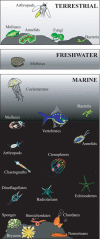Bioluminescence imaging: a shining future for cardiac regeneration
- PMID: 23402217
- PMCID: PMC3823173
- DOI: 10.1111/jcmm.12018
Bioluminescence imaging: a shining future for cardiac regeneration
Abstract
Advances in bioanalytical techniques have become crucial for both basic research and medical practice. One example, bioluminescence imaging (BLI), is based on the application of natural reactants with light-emitting capabilities (photoproteins and luciferases) isolated from a widespread group of organisms. The main challenges in cardiac regeneration remain unresolved, but a vast number of studies have harnessed BLI with the discovery of aequorin and green fluorescent proteins. First described in the luminous hydromedusan Aequorea victoria in the early 1960s, bioluminescent proteins have greatly contributed to the design and initiation of ongoing cell-based clinical trials on cardiovascular diseases. In conjunction with advances in reporter gene technology, BLI provides valuable information about the location and functional status of regenerative cells implanted into numerous animal models of disease. The purpose of this review was to present the great potential of BLI, among other existing imaging modalities, to refine effectiveness and underlying mechanisms of cardiac cell therapy. We recount the first discovery of natural primary compounds with light-emitting capabilities, and follow their applications to bioanalysis. We also illustrate insights and perspectives on BLI to illuminate current efforts in cardiac regeneration, where the future is bright.
© 2013 The Authors Journal of Cellular and Molecular Medicine Published by Foundation for Cellular and Molecular Medicine/Blackwell Publishing Ltd.
Figures





References
-
- Herring PJ. How to survive in the dark: bioluminescence in the deep sea. Symp Soc Exp Biol. 1985;39:323–50. - PubMed
-
- Widder EA. Bioluminescence in the ocean: origins of biological, chemical, and ecological diversity. Science. 2010;328:704–8. - PubMed
-
- Hastings JW. Biological diversity, chemical mechanisms, and the evolutionary origins of bioluminescent systems. J Mol Evol. 1983;19:309–21. - PubMed
-
- Olivetti G, Capasso JM, Meggs LG, et al. Cellular basis of chronic ventricular remodeling after myocardial infarction in rats. Circ Res. 1991;68:856–69. - PubMed
Publication types
MeSH terms
Substances
LinkOut - more resources
Full Text Sources
Other Literature Sources

